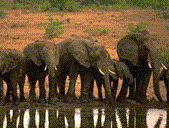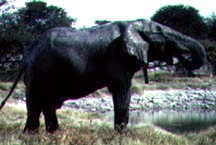

 This is the world’s largest land mammal, and weighs up to seven tonnes and reaches heights of
3.3 m at the shoulder. Elephants can live to a potential age of 70 years. The massive tusks
of older bulls can weigh up to 50 or 60 kilograms, but tusks weighing up to 90 kilograms
have been recorded.
This is the world’s largest land mammal, and weighs up to seven tonnes and reaches heights of
3.3 m at the shoulder. Elephants can live to a potential age of 70 years. The massive tusks
of older bulls can weigh up to 50 or 60 kilograms, but tusks weighing up to 90 kilograms
have been recorded.
 The Elephant’s trunk is very sensitive and can even detect water under ground. There are as
many as 50 000 muscles in an elephant’s trunk. The sensitive finger-like appendages at the
tip of the trunk enables them to pick the smallest twig or flower.
The Elephant’s trunk is very sensitive and can even detect water under ground. There are as
many as 50 000 muscles in an elephant’s trunk. The sensitive finger-like appendages at the
tip of the trunk enables them to pick the smallest twig or flower.
 Elephants are voracious feeders which in a day consume up to 272 Kg of grass, tender shoots
and bark from trees. An adult Elephant can drink up to 200 litres of water in a single session.
Elephants are voracious feeders which in a day consume up to 272 Kg of grass, tender shoots
and bark from trees. An adult Elephant can drink up to 200 litres of water in a single session.
 African Elephants are not seasonal breeders. Generally they produce one calf every three to
four years. The gestation period is about 22 months. At birth calves weigh about 100 Kg and
are fully weaned between 18-24 months.
African Elephants are not seasonal breeders. Generally they produce one calf every three to
four years. The gestation period is about 22 months. At birth calves weigh about 100 Kg and
are fully weaned between 18-24 months. An orphaned calf will usually be adopted by one of the family's lactating females or suckled
by various females. Elephants are very attentive mothers, and because most elephant behavior
has to be learned, they keep their offspring with them for many years. Tusks erupt at 16 months
but do not show externally until 30 months. Once weaned usually at age 4 or 5, the calf still
remains in the maternal group.
An orphaned calf will usually be adopted by one of the family's lactating females or suckled
by various females. Elephants are very attentive mothers, and because most elephant behavior
has to be learned, they keep their offspring with them for many years. Tusks erupt at 16 months
but do not show externally until 30 months. Once weaned usually at age 4 or 5, the calf still
remains in the maternal group.
 Mature males form bachelor groups or become solitary bulls. Elephants form strong family units of
cows, calves and young offspring. Such herds are always led by an old female. Apart from drinking
large quantities of water they also love wading or swimming in it. Elephants clearly relish mud
baths.
Mature males form bachelor groups or become solitary bulls. Elephants form strong family units of
cows, calves and young offspring. Such herds are always led by an old female. Apart from drinking
large quantities of water they also love wading or swimming in it. Elephants clearly relish mud
baths.
 Females mature at about 11 years and stay in the group, while the males, which mature between
12 and 15, are usually expelled from the maternal herd. Even though these young males are sexually
mature, they do not breed until they are in their mid, or late 20s or even older and have moved
up in the social hierarchy
Females mature at about 11 years and stay in the group, while the males, which mature between
12 and 15, are usually expelled from the maternal herd. Even though these young males are sexually
mature, they do not breed until they are in their mid, or late 20s or even older and have moved
up in the social hierarchy



© 2002 -
"The Lone Tree Safari Lodge
All Rights Reserved"